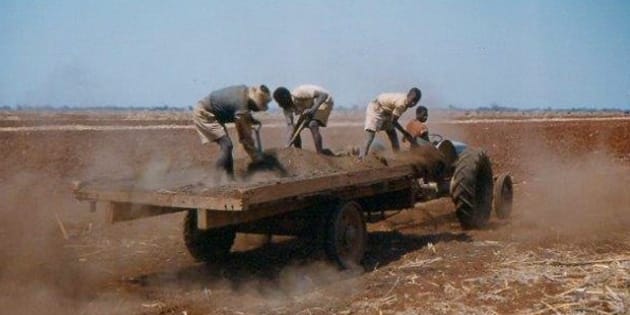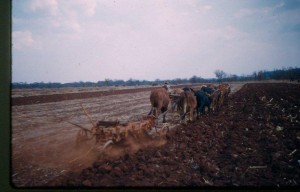All in a Day's Work

Spreading Manure on the lands at Melrose Farm, outside Que Que, Southern Rhodesia 1961
All in a Day’s Work
A typical week at Melrose Farm for Tim Hughes started with a cup of tea from his ‘cookboy’ Mark before daylight. After pulling on his khaki shirt, shorts, boots and hat, he’d hurry to the workshop to beat the simbi (metal plough disc) to summon the workers, just as the sun popped over the horizon. He’d mark their attendance cards and detail them to their various jobs.
All in a Day’s Work
His father, Gervas Hughes, ‘Matambega’, trained Tim to plan the following day’s work for each man. Absentees and any late arrivals, who were sent home, lost their pay for that day. They were allowed two hours to cook and eat their sadza (stiff maize meal porridge). Then they worked until sundown. If piece-work was available, such as weeding ten rows of maize per day (each more than a kilometre long), and they worked hard, they could finish in eight hours.
Once they were on the job he’d return to the house for breakfast and then check on the work in the workshop. If parts or shopping were required, he’d drive to Gwelo or Que Que.
The rains were late. Everything was drought stricken.
On one of Gervas’ regular inspections of Melrose, he instructed Tim to erect a fence using star steel posts with five barbed wires, strung across the maize lands dividing the five hundred hectare paddock in two to control his cattle when they fed on maize stalks after harvesting. When the perfectly straight fence was completed, he proudly showed his mile long masterpiece to Matambega.
Gervas told him to pull it down. He wanted every post orientated so that a plain wire would go straight through all the holes. Since it was a barbed wire fence with the wire tied to the side of the posts with tie wire, Tim hadn’t even noticed.
After his father left, he drove along the fence with a worker and in an hour twisted each of the offending steel posts at ground level with a large pipe spanner until they were perfectly aligned. Matambega seemed satisfied the following week.
Planting rains arrived just before the window of opportunity closed for putting maize seed into the ground. Tim pushed his men hard to cover all the areas that had been so carefully prepared. He drove a planter tractor himself while the men had their noon two hour meal break and again when they said it was too dark to see. The crop, a month later, looked a picture. Tim admired his vast area of healthy maize plants in perfectly straight rows, with hardly a weed to be seen.
They always ploughed throughout the dry winters and spring before the first rains of early summer. Gervas used teams of oxen for the heavy work and a few small grey Ferguson tractors.
“Dad, how about buying a big Ford tractor, like our neighbours, so we can plough day and night and get it over with?”
He replied “I can plough my land at a fraction of the large tractor costs. While I have Johan and Knockudown and the trained oxen, I’ll keep doing it the old way.” Each drove a span of sixteen oxen pulling a three furrow trailed disc plough. They in-spanned before daylight, ploughed till 9am, grazed and watered during the heat of the day then worked till sunset. The oxen, rested, watered and grazed at night, were willing workers for six days a week. It took them three months to complete the ploughing!
So Tim couldn’t have a holiday in the winter. He didn’t think his darling Eleanor should become a Rhodesian farmer’s wife.

Gervas Hughes drove a span of sixteen oxen pulling a three furrow trailed disc plough long after others were ploughing with tractors.
Many thanks to Tim Hughes for this excerpt and photo from his unpublished manuscript Matambega and Son written in the 1980’s.
